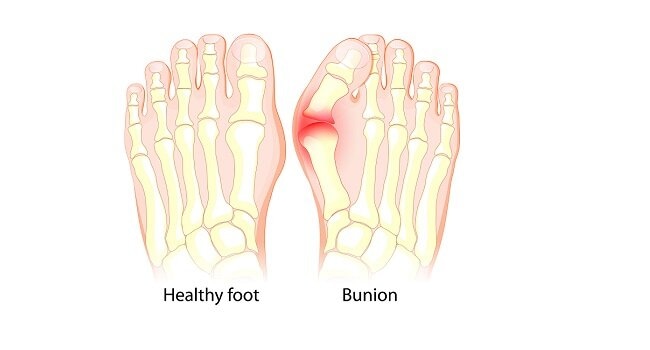A bunion (hallux valgus) is a bump at your big toe’s base.
Typically, the big toe should stay in a straight position. However, various factors can cause a deformity in the foot bones, making the big toe lean more toward the second toe. The top moves inwards, and the joint at the toe’s base protrudes outward.
If the unusual angle isn’t corrected early, your big toe becomes significantly misaligned, and a bony bump appears.
It’s just as painful as you picture it. Bunions often get in the way of convenient movement, which can significantly lower your quality of life over time. Here’s what you need to know about them and what you must do to treat them.
Causes And Symptoms Of Bunions
It’s common to find more women with bunions than men. Also, older adults are more likely to develop the condition. However, this deformity can affect anyone, regardless of age or gender.
Several factors lead to bunions. These include the following:
- Faulty Foot Shape And Pressure
A bunion can result from a faulty foot shape and pressure from how you walk. You’re at a higher risk of developing bunions if you have abnormal bone structure, flat feet, or excessively flexible ligaments.
- Family History
Bunions are also thought to be hereditary. You’ll likely develop bunions if your family has a history of foot structure issues like flat feet.
- Poor Lifestyle Choices
Your lifestyle may also increase the likelihood of getting bunions. For instance, standing for long hours exerts excess pressure on your feet’s tissues. Wearing shoes that are too small or tight, such as pointed or high-heeled footwear, has the same effect.
- Foot Injuries
Some foot injuries can weaken your midfoot ligaments, causing the big toe to become misaligned. Furthermore, other injuries can negatively impact how you walk, increasing the risk of bunions forming.
Recognizing the early signs of bunions should help you get earlier intervention, which is vital for preventing deformities. Some notable symptoms include a strange protrusion along your toe line, pain, inflammation, stiffness, irritation, numbness, and redness on your big toe.
Types Of Bunions
Most bunions come in the following forms:
- Congenital bunions: Bunions can affect babies. These are called congenital bunions and are mostly hereditary.
- Adolescent or juvenile bunions: Adolescent or juvenile bunions affect children between 10-15 years old and are also hereditary. They’re less painful and don’t significantly affect movement compared to adult bunions.
- Large bunions: Large bunions cause the joint at your toe’s base—the metatarsophalangeal (MTP) joint—to protrude significantly. The resulting bump can get noticeably big. Patients with large bunions experience pain and have difficulty moving the affected toes and wearing shoes.
- Tailor’s bunions: Though bunions are common on the big toe, some can form on the little toe. These are called tailor’s bunions or bunionettes. The little toe leans more toward the fourth toe, and a bump appears on the base outside.
Regardless of the kind or cause of the bunions on your feet, medical intervention is crucial for treating them. A good orthopedic or podiatrist can treat the condition or help you manage the symptoms effectively through surgical or non-surgical means.
How Do Bunions Impact Your Well-Being?
Though bunion treatment and management strategies exist, seeking medical attention as early as possible is essential. This is because the condition doesn’t go away on its own. Instead, it progresses and can permanently change your foot’s structure.
Besides affecting your feet, bunions can also negatively impact your social, mental, and physical well-being.
That said, it’s best to work with experts. You can consider local healthcare providers or online professionals from sites like https://www.tetonfootandankle.com/. Work with those that are reputable, reliable, certified, well-trained, and experienced.
Below are ways bunions can negatively impact your overall health if not addressed in time:
1. Severe Foot Complications
Delayed medical treatment can cause other severe foot problems to develop. Some of these include:
-
Osteoarthritis
Some foot specialists believe that bunions can increase the risk of developing osteoarthritis. This is because the deformity can stiffen your toe, reducing your range of motion. That can exacerbate other issues affecting the tissues deep inside, eventually leading to overall inflammation.
-
Metatarsalgia
Bunions make you shift weight off the big toe due to pain. This puts more pressure on the balls of your feet. This results in a complication called metatarsalgia, which manifests as swelling and pain on the front part of your feet.
-
Calluses
Calluses are thick skin layers that mostly occur where there’s repeated friction. Bunions cause your toes to rub against each other, increasing the risk of developing calluses in the spaces between.
-
Hammer Toe
A hammer toe is a foot complication where your toe gets an unusual bend in the middle joint. Typically, bunions cause your big toe to move out of the normal position. As a result, the next toe experiences more pressure, making it bend downwards.
-
Bursitis
Bursitis is an uncomfortable and painful foot complication that develops when the fluid-filled pads cushioning bones near your joints become inflamed.
As you can see, these complications directly impact your feet. Unfortunately, they don’t stop there.
2. Limited Foot Function
As bunions grow bigger, they can negatively affect your foot function in several ways.
Usually, the big toe provides more balance and increases leverage as you push your foot off the ground. The MTP joint helps prevent significant pressure by bearing and distributing weight created by this motion.
Bunions damage your MTP joint and toe, cause pain while moving, and impair your balance and gait. As a result, you may lose some foot function. This condition also increases the risk of developing ingrown toenails on the affected foot, which can be painful.
3. Discomfort In Other Body Parts
Impaired balance, gait dysfunction, and walking pain can affect other body parts. These include your hips, knees, feet, and lower back.
These areas will experience more stress and pressure as you try to move differently to avoid or minimize pain caused by bunions. As a result, you’ll feel the secondary effects of bunions, like pain or fatigue in said parts.
4. Shopping Stress
Finding the perfect pair can be challenging for anyone with bunions. Your choices are limited, whether you’re shopping online or in a physical store.
The best shoes for bunions fit well and don’t put more pressure on the affected toes or foot, keeping pain and discomfort at a minimum.
It may be necessary to consult a foot specialist to learn which shoe styles suit you. They may advise buying footwear with good arch support, wider toe boxes, two inches heel or less, and flexible uppers. These aren’t fashionable, but they help prevent further strain.
5. Difficulty Exercising
Many healthcare experts emphasize the need for regular exercise. This is mainly because physical activity can improve a person’s health and overall well-being in several ways.
For instance, exercising can help you maintain a healthy weight, improve brain function, and strengthen muscles and bones. Moreover, physical activity can lower anxiety and stress, increase energy, and reduce the risk of illnesses like diabetes.
Bunions can limit your ability to exercise due to swelling, pain, and other discomforts that make it challenging even to walk small distances. If you need to increase your physical activity to stay healthy, all the more so that you need to have this deformity treated.
6. Social Anxiety
Bunions can also cause social anxiety because you may not want anyone to see your feet. You’ll find yourself feeling nervous about wearing sandals or going barefoot. Also, you might not visit people’s homes where you know they may require you to remove your footwear. That includes shoe-free events like beach or pool parties.
Never Look Past Them
Bunions can negatively affect various aspects of your life regardless of their causes or types. As you’ve learned in this article, if unaddressed early, they can lead to severe foot complications that get in the way of your lifestyle.

A foot specialist may recommend non-invasive treatments like medication, bunion pads, special shoes, or custom orthotics. These help prevent bunion progression and manage pain, inflammation, and other symptoms. However, surgery may be your best recourse if the above treatments are ineffective or you’re dealing with severe cases.
Consult the experts for the best solutions.


















